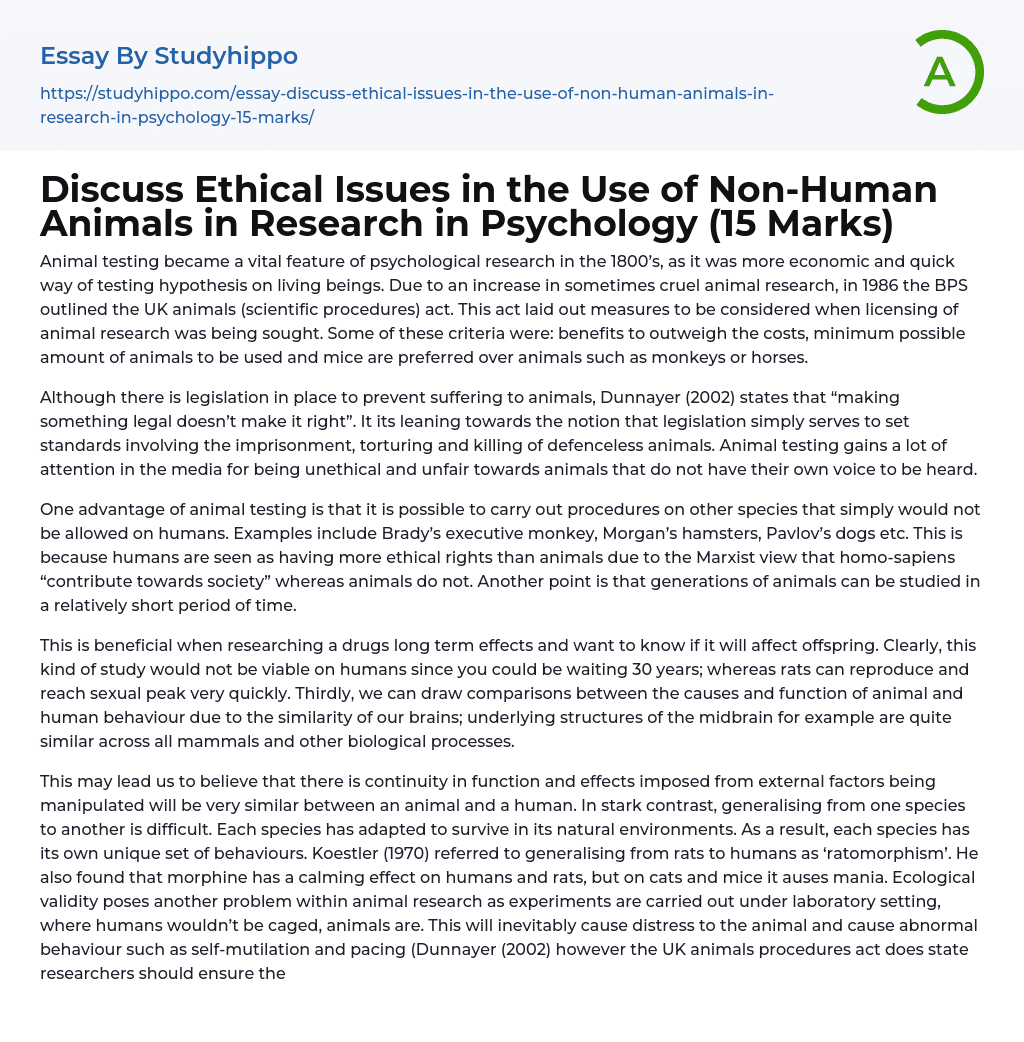

Animal Testing and the UK Animals (Scientific Procedures) Act of 1986
Animal testing became a vital feature of psychological research in the 1800’s, as it was more economic and quick way of testing hypothesis on living beings. Due to an increase in sometimes cruel animal research, in 1986 the BPS outlined the UK animals (scientific procedures) act. This act laid out measures to be considered when licensing of animal research was being sought. Some of these criteria were: benefits to outweigh the costs, minimum possible amount of animals to be used and mice are preferred over animals such as monkeys or horses.
Although there is legislation in place to prevent suffering to animals, Dunnayer (2002) states that “making something legal doesn’t make it right”. It its leaning towards the notion that legislation simply serves to set standards involving the imprisonment, torturing and killing of defenceless ani
...mals. Animal testing gains a lot of attention in the media for being unethical and unfair towards animals that do not have their own voice to be heard.
One advantage of animal testing is that it is possible to carry out procedures on other species that simply would not be allowed on humans. Examples include Brady’s executive monkey, Morgan’s hamsters, Pavlov’s dogs etc. This is because humans are seen as having more ethical rights than animals due to the Marxist view that homo-sapiens “contribute towards society” whereas animals do not. Another point is that generations of animals can be studied in a relatively short period of time.
This is beneficial when researching a drugs long term effects and want to know if it will affect offspring. Clearly, this kind of study would not be viable on humans since
you could be waiting 30 years; whereas rats can reproduce and reach sexual peak very quickly. Thirdly, we can draw comparisons between the causes and function of animal and human behaviour due to the similarity of our brains; underlying structures of the midbrain for example are quite similar across all mammals and other biological processes.
This may lead us to believe that there is continuity in function and effects imposed from external factors being manipulated will be very similar between an animal and a human. In stark contrast, generalising from one species to another is difficult. Each species has adapted to survive in its natural environments. As a result, each species has its own unique set of behaviours. Koestler (1970) referred to generalising from rats to humans as ‘ratomorphism’. He also found that morphine has a calming effect on humans and rats, but on cats and mice it auses mania. Ecological validity poses another problem within animal research as experiments are carried out under laboratory setting, where humans wouldn’t be caged, animals are. This will inevitably cause distress to the animal and cause abnormal behaviour such as self-mutilation and pacing (Dunnayer (2002) however the UK animals procedures act does state researchers should ensure the environment is appropriate for the species being used and where possible a naturalistic environment should be used).
Other behaviours such as mating may become inhibited like with captive pandas. Finally, animals are unable to verbalise what they are feeling. This sets human apart from other species, animals show limited behaviour to indicated the effects of drugs, theories etc. For example, we can understand when an animal is in pain
or distressed, but not the extent to which they are suffering which may be crucial in research results. This could affect the validity of a study.
- Rabbit essays
- Distribution essays
- Large Animals essays
- Mouse essays
- Poultry essays
- Animal Abuse essays
- Cats Vs Dogs essays
- Cattle essays
- Territory essays
- Abnormal Psychology essays
- Social Psychology essays
- Developmental Psychology essays
- Jean Piaget essays
- Positive Psychology essays
- Classical Conditioning essays
- Counseling essays
- Psychoanalysis essays
- Educational Psychology essays
- Behaviorism essays
- Authority essays
- Operant Conditioning essays
- Maslow's Hierarchy Of Needs essays
- Mental Health essays
- Personality Psychology essays
- Psychotherapy essays
- Family Therapy essays
- Stanford Prison Experiment essays
- Abraham Maslow essays
- Erik Erikson essays
- Cognitive Psychology essays
- Sigmund Freud essays
- Attachment Theory essays
- Supersize Me essays
- Individual essays
- Infant essays
- Childhood essays
- Adolescence essays
- Growth Mindset essays
- Is Google Making Us Stupid essays
- Childhood Memory essays
- Positive Attitude essays
- Reinforcement essays
- Archetype essays
- Maturity essays
- Deception essays
- Certainty essays
- Conformity essays
- Aggression essays
- Behavior essays
- Human Behavior essays



